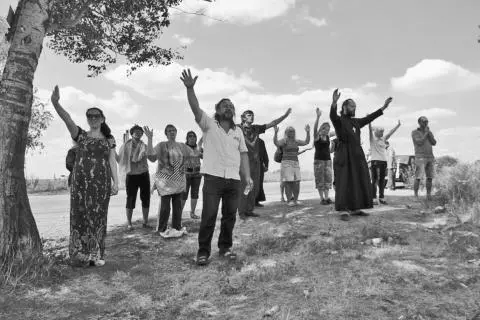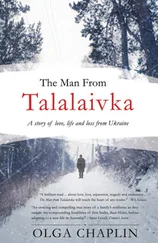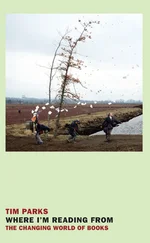
A group prays for peace on the outskirts of Mariupol. August 2014.
The ceasefire began to falter seriously, however, in December and collapsed completely in the new year. At the same time Ukraine’s forces were slowly growing more organized. Gradually the militias were being absorbed into a proper command and control structure and Ukrainian soldiers were becoming more effective. They were also digging in around Mariupol. The rebels, however, wanted them out of two places in particular—Donetsk airport and the town of Debaltseve, through which local roads and railways run. The airport, named for the famous composer Sergei Prokofiev (1891–1953), who was born nearby, was gleaming and new, having been among those rebuilt for the 2012 Euro soccer championships. By the time the Ukrainians were expelled from it, on January 21, 2015, it was mostly rubble. A new ceasefire was agreed, with a starting date of February 15, but the rebels, even with Russian military help, were unable to push the Ukrainians out until February 18. The airport and Debaltseve were certainly defeats for the Ukrainians, but the fact that it took the rebels and the Russians months to achieve these victories demonstrated two things: first, that the Ukrainians were no longer disorganized and that their military was getting stronger by the day; and secondly, that the rebels and the Russians were reaching the limits of what they could do unless there was a lot more help from Russia. This in turn risked triggering new sanctions and probably individual Western countries moving to give Ukraine the modern lethal weaponry—for example, the targeting systems—it was asking for.
With so many people leaving the rebel territories, logic dictated that more Russians, either volunteers, troops on contract (to disguise the fact that they were regulars) or just regulars, would be needed simply to hold the rebel territories, let alone to expand them. In other words, the expansive fantasy of a Novorossiya all the way to Bessarabia had collapsed and was being replaced with the uncomfortable reality of a frozen conflict, similar to Transnistria, South Ossetia, Abkhazia and Nagorno-Karabakh. From Putin’s point of view, it must have seemed if not exactly glorious, still a useful outcome furthering his aim of trying to prevent Ukraine from becoming an attractive country, with a stable democracy which could both serve as an example to Russians and also have a serious prospect of eventual NATO and EU accession. For the people of the rebel territories their prospect was simply one of poverty and no hope of a better future. In the center of Donetsk life continued with superficial normality, but shops, banks and offices were closed and in many places sporadic fighting continued. For everyone here, life was in limbo.
One place where fighting continued was Adminposiolok, a badly shattered rebel-held suburb of Donetsk, close to the airport. While the Ukrainians had indeed lost it, they were only a kilometer or two away. Adminposiolok was an eerie place, almost entirely empty of people. All of a sudden Ivan Tokarev, aged seventy-eight, arrived on his bike to do some cleaning in his apartment in a large residential block. Every single apartment in the front of the building facing the Ukrainian lines had been destroyed or rendered uninhabitable. His was in decent shape, however, because it was at the back. He showed me a hole in the floor of one apartment in which a shell or rocket had fallen, blowing up the flat of his son below. No one lived there anymore. His son had gone to Russia. Ivan and his wife, who had moved to a safer part of town, did not want to join them, he said, because while it might be fine for a month or two, then everyone would start arguing, so it was “better to die here.”

Azov Battalion insignia. Mariupol, March 2015.
The Azov Battalion, based in Mariupol, the Ukrainian-controlled port on the Sea of Azov, is small. According to Major Andrey Dyachenko, its twenty-eight-year-old spokesman, when the battalion was founded in May 2014 it had some sixty men but ten months later it had “more than a thousand.” That is a tiny proportion of the 60,000 men under arms actively fighting for Ukraine out of a total number of 250,000 in the armed forces, but judging by the publicity they have garnered for themselves in innumerable news reports, you might be forgiven for thinking that there were 100,000 of them. As Russian officials and the Russian media have accused the post-Maidan revolution governments in Kiev of being neo-Nazis and fascists, the Azov Battalion is perfect camera fodder, its members parading around with their neo-Nazi-style flag and symbols. If they were not invented and paid for by a secret Russian department of misinformation, then those in charge of directing Russian propaganda must have been thanking their lucky stars that they came along all by themselves.
In terms of winning the war for global public opinion, the Azov Battalion and the charge of Ukrainian neo-Nazism, fascism and extreme nationalism all combine to make Ukraine’s Achilles’ heel. Small elements of truth have painted, and allowed the Russian media and their Western fellow travelers to paint, an utterly distorted picture of the whole. In the general election of October 2014 Ukraine’s far-right parties flopped. In electoral terms they are insignificant compared to their strength in Hungary, France or Italy, for example. And yet, many Westerners do not see this. Many also do not see that much of the Russian propaganda aimed at depicting Ukraine as a kind of Third Reich reincarnated is a sort of displacement activity. It is, after all, Russia which is in the grip of nationalistic euphoria and whose once nascent democracy has died as people rally round its one and only unchallenged leader.
Ukraine’s problem, however, is that there are indeed real unpleasant elements that give its enemies the opportunity to exaggerate their significance. All European countries have the same extremists, but the issue of their existence is not a neuralgic political one because they are not fighting wars. Also, when it comes to the Azov Battalion, for example, its political antecedents mean that it has friends in high places and because it is a volunteer unit, its members are highly motivated and it garners support because it is successful. This in turn means that it receives more publicity than its numbers justify.
In its canteen we collected soup and bread. Behind us three men were talking in thickly accented English. The Azov Battalion is the one which foreigners, especially those affiliated with far-right and neo-Nazi groups from Croatia to Scandinavia, come to fight for. Just like the volunteers on the other side of the line, they are a mix of adventurers and true believers.
The Azov Battalion, or rather Patriot of Ukraine, the political movement it sprang from, was founded in 2005 according to spokesman Dyachenko. Its leader was, and is, the thirty-six-year-old Andrey Biletsky, and it began in the northeastern city of Kharkiv, which proved, said Dyachenko, that it was untrue “that Ukrainian nationalism comes only from the west.” From the beginning, members of the organization had believed “that Ukraine would have to fight for its independence… In 1991 Ukraine gained its independence for geopolitical reasons, without blood or fighting, but historically we know that nothing comes for free. Even though our parents did not take up arms to fight for independence, now we have to do it.”
Читать дальше














